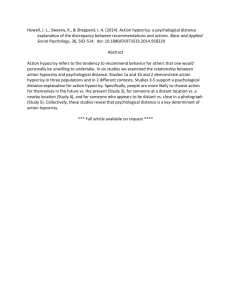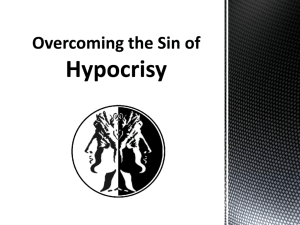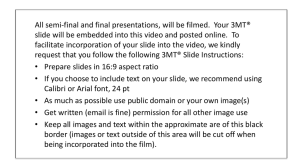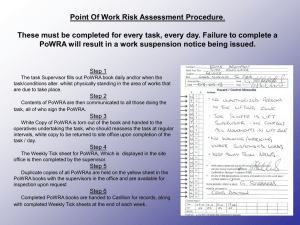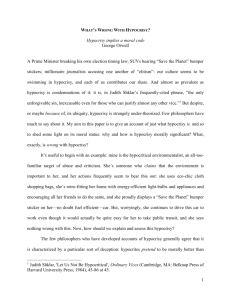When Leaders Fail to “Walk the Talk:” An
advertisement
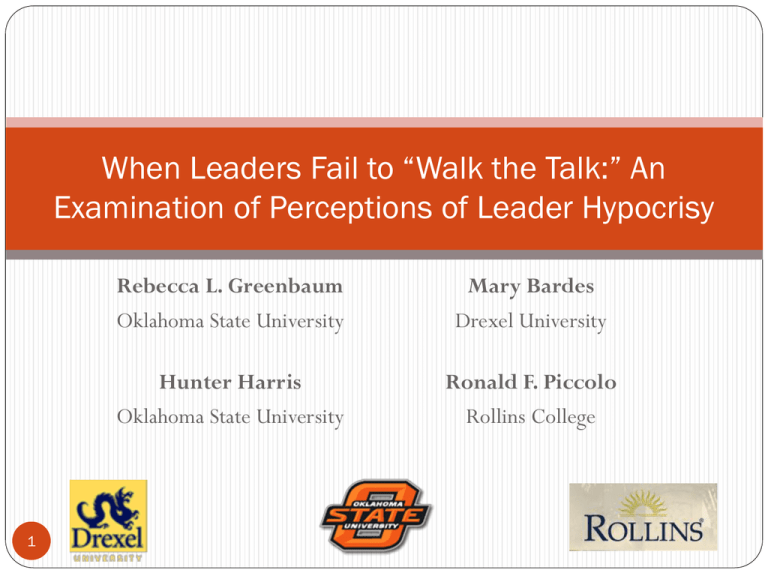
When Leaders Fail to “Walk the Talk:” An Examination of Perceptions of Leader Hypocrisy 1 Rebecca L. Greenbaum Oklahoma State University Mary Bardes Drexel University Hunter Harris Oklahoma State University Ronald F. Piccolo Rollins College Perceptions of Leader Hypocrisy Leadership’s dark side (Popper, 2001; Tierney & Tepper, 2007) Definition (antonym of behavioral integrity; Simons, 2002) The leader expresses certain values, but fails to uphold those values as demonstrated by his/her attitudes and behaviors (Cha & Edmondson, 2006; Treviño, Hartman, & Brown, 2000). Employees’ perceptions of leaders’ word-deed misalignment (Brunnson, 1989; Simons, 2002). Why study leader hypocrisy? Subordinates pay attention to salient values (Salancik & Pfeffer, 1978). 2 Research Question ? A Hypocrisy Condition: Word-deed Misalignment 3 Perceptions of Leader Hypocrisy Turnover Intentions A Hypocrisy-driven Outcome (Simons et al., 2007) Research Question Interpersonal Justice Expectation Supervisor Undermining A Hypocrisy Condition: Word-deed Misalignment 4 Perceptions of Leader Hypocrisy Turnover Intentions Control Variables: Psychological Contract Breach Trust in Supervisor A Hypocrisy Condition Supervisor Undermining “[Supervisory] behavior that is intended to hinder, over time, the ability [of subordinates] to establish and maintain positive interpersonal relationships, work-related success, and favorable reputations” (Duffy et al., 2002; p. 332). Interpersonal Justice (IPJ) (Bies, 2005; Bies & Moag, 1986; Colquitt, 2001; Greenberg, 1993) Respectful and socially sensitive treatment IPJ Expectation Subordinates perceive that their supervisors expect them to treat others with interpersonal justice. 5 Misalignment Supervisor Undermining A failure to show subordinates dignity/respect Belittling subordinates ideas, making them feel incompetent, spreading rumors about them, talking badly about them (Duffy et al., 2002) The presence of IPJ expectation adds insult to injury. Subordinates pay attention to salient expectations (Salancik & Pfeffer, 1978). It’s clearer to subordinates that supervisors do not “walk the talk.” “Not only does my supervisor treat me poorly, but he/she is a hypocrite!” 6 Hypothesis 1: The interactive effect of supervisor undermining and interpersonal justice expectation is related to perceptions of leader hypocrisy such that the relationship between supervisor undermining and perceptions of leader hypocrisy is stronger when interpersonal justice expectation is high as opposed to low. Interpersonal Justice Expectation Supervisor Undermining 7 Perceptions of Leader Hypocrisy Why do subordinates care? A theoretical explanation to account for reactions to leader hypocrisy (Gosling & Huang, 2009) Cognitive dissonance theory (Festinger, 1957) is used to account for people’s reactions to their own hypocrisy (Stone & Cooper, 2001). Employees may also experience psychological discomfort (i.e., dissonance) in response to leader hypocrisy. People derive a part of their self-concepts from their work groups (Tajfel, 1978; Tajfel & Turner, 1979). People care about the hypocrisy of work group members (McKimmie et al., 2003). Leaders serve as exemplars of group conduct (Brown et al., 2005; Mayer et al., 2009). 8 Dissonance Reduction: Turnover Intentions Employees experience dissonance arousal in response to leader hypocrisy. An association with hypocritical leaders challenges employees’ understanding of themselves as moral people (McKimmie et al., 2003; Thibodeau & Aronson, 1992). Employees are motivated to reduce dissonance (Festinger, 1957). They may psychologically distance themselves from the source of hypocrisy by intending to leave the organization. 9 Hypothesis 2: Perceptions of leader hypocrisy are positively related to turnover intentions. Perceptions of Leader Hypocrisy 10 Turnover Intentions Hypothesis 3: Perceptions of leader hypocrisy mediates the relationship between the interactive effect of supervisor undermining and interpersonal justice expectation on turnover intentions. Interpersonal Justice Expectation Supervisor Undermining 11 Perceptions of Leader Hypocrisy Turnover Intentions Alternative Explanations (controls) Related Constructs (Simons, 2002; Simons et al., 2007) Psychological Contract Breach (Rousseau, 1989; Morrison & Robinson, 1997) Trust (Mayer et al., 1995) 12 Method: Participants and Procedure Business administration students recruited 533 working adults to participate in the survey Usable data from 312 participants (59% response rate) Average age = 26 years 58% Caucasian Average organizational tenure = 3 years 54% working full-time, 46% part-time 13 Method: Measures All measures were rated on a 7-point Likert-type scale (1 = strongly disagree, 7 = strongly agree) Supervisor Undermining (13 items; Duffy et al., 2002; α = .97) Does your supervisor “talk bad about you behind your back?” Interpersonal Justice Expectation (4 items; adapted from Colquitt, 2001; α = .96) My supervisor expects me to “treat other people with respect.” Perceptions of Leader Hypocrisy (4 items; Dineen et al., 2006; α = .92) “I wish my supervisor would practice what he/she preaches more often.” 14 Method: Measures (continued) Turnover Intentions (4 items; adapted from Tett & Meyer, 1993; α = .95) “I am thinking about leaving this organization.” Controls Variables: Psychological Contract Breach (5 items; Morrison & Robinson, 1997; α = .91) “My employer has broken many of its promises to me even though I’ve upheld my side of the deal.” Trust in Supervisor (3 items; Conger et al., 2000; α = .82) 15 “I can count on my supervisor to be trustworthy.” Confirmatory Factor Analyses 16 Results (Preacher et al., 2007) Hypothesis 1 was supported. B = .10, p < .05 Simple slopes analysis (Aiken & West, 1991): One standard deviation below the mean: t =2.04, p < .05 One standard deviation above the mean: t = 4.17, p < .001 17 Hypothesis 1 Interaction 18 Results (continued) Hypothesis 2 was supported. B = .22, p < .01 Moderated mediation results (Preacher et al., 2007) provided support for Hypothesis 3. -1 SD (4.76), B = .02, ns SD (6.05), B = .06, p < .05 +1 SD (7.35), B = .09, p < .05 Bootstrap indirect effects -1 SD (4.76), B = .04, ns SD (6.05), B = .07, p < .10 +1 SD (7.35), B = .10, p < .05 19 Indirect Effects at Levels of the Moderator 20 Discussion Our results suggest that the simultaneous presence of supervisor undermining and interpersonal justice expectation leads to perceptions of leader hypocrisy, which then leads to turnover intentions. Our result hold even when controlling for alternative explanations (i.e., psychological contract breach, trust in supervisor). 21 Discussion (continued) Theoretical Implications Leader hypocrisy may be even worse than other forms of bad leadership. Employees’ reactions may also be driven by implicit expectations derived from societal norms concerning fair behavior (Cropanzano et al., 2003; Folger et al., 2005). Cognitive dissonance (Festinger, 1957) may explain employees’ desire to leave the organization. By controlling for alternative explanations, our results suggest that perceptions of leader hypocrisy is capturing something unique. 22 Discussion (continued) Practical Implications Leaders should be cognizant of instances where their attitudes/behavior may not align with expressed expectations. Limitations and Future Directions Common-method variance (Podsakoff et al., 2003; Spector, 2006) and cross-sectional data We also tested our model using a scenario-based experiment. Measurement of dissonance arousal The severity of hypocrisy 23 Thank you! Any questions? 24
